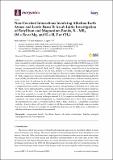Por favor, use este identificador para citar o enlazar a este item:
http://hdl.handle.net/10261/178936COMPARTIR / EXPORTAR:
 SHARE SHARE
 CORE
BASE CORE
BASE
|
|
| Visualizar otros formatos: MARC | Dublin Core | RDF | ORE | MODS | METS | DIDL | DATACITE | |

| Título: | Non-Covalent Interactions Involving Alkaline-Earth Atoms and Lewis Bases B: An ab Initio Investigation of Beryllium and Magnesium Bonds, B···MR2 (M = Be or Mg, and R = H, F or CH3) |
Autor: | Alkorta, Ibon CSIC ORCID ; Legon, Anthony C. | Palabras clave: | Magnesium bonds Beryllium bonds Ab initio calculations Binding strength Electrophilicity and nucleophilicity |
Fecha de publicación: | 5-mar-2019 | Editor: | Multidisciplinary Digital Publishing Institute | Citación: | Inorganics 7(3): 35 (2019) | Resumen: | Geometries, equilibrium dissociation energies (De), intermolecular stretching, and quadratic force constants (kσ) determined by ab initio calculations conducted at the CCSD(T)/aug-cc-pVTZ level of theory, with De obtained by using the complete basis set (CBS) extrapolation [CCSD(T)/CBS energy], are presented for the B···BeR2 and B···MgR2 complexes, where B is one of the following Lewis bases: CO, H2S, PH3, HCN, H2O or NH3, and R is H, F or CH3. The BeR2 and MgR2 precursor molecules were shown to be linear and non-dipolar. The non-covalent intermolecular bond in the B···BeR2 complexes is shown to result from the interaction of the electrophilic band around the Be atom of BeR2 (as indicated by the molecular electrostatic potential surface) with non-bonding electron pairs of the base, B, and may be described as a beryllium bond by analogy with complexes such as B···CO2, which contain a tetrel bond. The conclusions for the B···MgR2 series are similar and a magnesium bond can be correspondingly invoked. The geometries established for B···BeR2 and B···MgR2 can be rationalized by a simple rule previously enunciated for tetrel-bonded complexes of the type B···CO2. It is also shown that the dissociation energy, De, is directly proportional to the force constant, kσ, in each B···MR2 series, but with a constant of proportionality different from that established for many hydrogen-bonded B···HX complexes and halogen-bonded B···XY complexes. The values of the electrophilicity, EA, determined from the De for B···BeR2 complexes for the individual Lewis acids, A, reveal the order A = BeF2 > BeH2 > Be(CH3)2—a result that is consistent with the −I and +I effects of F and CH3 relative to H. The conclusions for the MgR2 series are similar but, for a given R, they have smaller electrophilicities than those of the BeR2 series. A definition of alkaline-earth non-covalent bonds is presented | Versión del editor: | http://dx.doi.org/10.3390/inorganics7030035 | URI: | http://hdl.handle.net/10261/178936 | DOI: | 10.3390/inorganics7030035 | ISSN: | 2304-6740 |
| Aparece en las colecciones: | (IQM) Artículos |
Ficheros en este ítem:
| Fichero | Descripción | Tamaño | Formato | |
|---|---|---|---|---|
| inorganics-07-00035-v2.pdf | 3,33 MB | Adobe PDF |  Visualizar/Abrir |
CORE Recommender
WEB OF SCIENCETM
Citations
17
checked on 22-feb-2024
Page view(s)
239
checked on 05-may-2024
Download(s)
161
checked on 05-may-2024
Google ScholarTM
Check
Altmetric
Altmetric
Este item está licenciado bajo una Licencia Creative Commons

